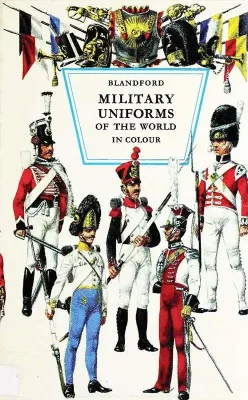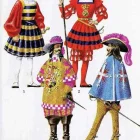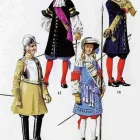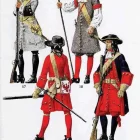- Military Library
- Literature
- Various Wars Books
- Military Uniforms of the World in Colour (published 1968)
Military Uniforms of the World in Colour (published 1968)
512 Illustrated Military Uniforms of the World from 1506 to 1965
This book illustrates 512 military uniforms of the world from the year 1506 until 1965. It provides a pocket encyclopedia of the soldiers of the world, with their history and heritage. The authenticity of the illustrations has been checked with the principal military museums of the nations concerned and the text gives not only the details of individual uniforms and regiments but also of the wars and campaigns in which particular regiments took part.
The uniforms are illustrated in chronological order, grouped according to the wars listed below. The numbers are those of the first uniform in the group, in both the illustrations and the text.
The book is the first real manual of its kind ever published in the English language, as well as the most comprehensive guide to uniforms available in the World today. It illustrates and describes more than five hundred uniforms worn past and present by the navies, armies and air forces of the world. They are dealt with war by war, in chronological order, from the germ of military uniforming in the bodyguards and household guards of the fifteenth and sixteenth centuries, via those of the European and colonial wars of the seventeenth, eighteenth and nineteenth, fought by troops in bright colors, to the field-grey and khaki of the two World Wars. The blue berets and steel helmets of the United Nations peace keeping forces with the traditional uniforms of guards and ceremonial units, logically bring up the rear of this cavalcade of uniforms.
Military uniforming as at present understood, that is, as a fixed form of dress officially prescribed, and which indicates that its wearer belongs to a particular unit, branch or force, is of relatively recent date in the historical context. Uniforms proper came in with the formation of standing armies after the Thirty Years War. It is hardly possible to give the credit for inventing uniforms to a particular country, even less to a particular individual. The idea appeared simultaneously in several countries. From earliest times military clothing had a tendency towards uniformity, without being uniform in the true sense. There were various reasons for this: as with the Roman legions, uniformity could result from quantity-produced and state-supplied equipment. The need to distinguish friend from foe also played a part.
Military dress is strongly influenced by tradition : this is a factor that holds good for all periods and cultures. Even today, as in earlier periods, uniforms bear a firm impress of the familiar. Long after the original function of a piece of equipment is forgotten it is retained as a traditional or symbolic ornament in military dress. The need to distinguish friend from foe is counteracted by the tendency in uniforms to follow the dominant fashion, usually set by the dominant power.
Contents of the book
- Household Guards before 1670 (1)
- The Dutch Wars 1652-1678 (5)
- The Scanian War 1675-1679 (21)
- The War of the Palatinate 1688-1697 (29)
- The Great Northern War 1700-1721 (37)
- The War of the Spanish Succession 1702-1714 (45)
- The War of the Polish Succession 1733-1735 (57)
- The War of the Austrian Succession 1740-1748 (61)
- The Stuart Rising in Scotland 1745-1746 (81)
- The Seven Years War 1756-1763 (85)
- The Franco-British Colonial Wars 1756-1763 (117)
- The Polish Struggle for National Independence 1768-1772 (121)
- The American War of Independence 1776-1783 (125)
- The Russo-Swedish War 1788-1790 (145)
- The French Revolution 1792-1804 (149)
- The Campaign in Egypt 1798-1801 (177)
- The French Revolution 1792-1 804 (181)
- The Napoleonic Wars 1804-1815 (189)
- The Latin American Wars of Independence 1807-1825 (269)
- The Belgian and Polish Uprisings 1830-1831 (277)
- The Long Peace of the 1830's (281)
- The Greek Civil War 1831-1832 (285)
- The Spanish Carlist Uprising 1834-1839 (287)
- The Mexican War 1846-1848 (289)
- The European Insurrections 1847-1850 (293)
- The First Schleswig War 1848-1850 (297)
- The Crimean War 1854-1856 (301)
- The Franco-Austrian War 1859 (309)
- The Struggle for Italy's Unification 1860-1861 (317)
- The American Civil War 1861-1865 (325)
- The Mexican Adventure 1864-1867 (333)
- The Second Schleswig War 1864 (337)
- The Austro-Prussian War 1866 (341)
- The Franco-Prussian War 1870-1871 (349)
- Colonial Troops 1870-1960 (365)
- The Boer Wars 1880-1881 and 1899-1902 (381)
- The Russo-Japanese War 1904-1905 (385)
- The Balkans Wars (1912-1913 (389)
- Troops of the Great Powers at the Outbreak of the First World War 1914 (397)
- The First World War 1914-1918 (405)
- The Wars of Liberation in Eastern Europe 1918-1922 (437)
- The Second World War 1939-1945 (445)
- The United Nations Troops since 1950 (493)
- Contemporary Guard Units, etc. (501)
- Military Terminology (257)
- Index (271)
- {{#owner}}
- {{#url}} {{#avatarSrc}}
{{name}} {{/url}} {{^url}} {{#avatar}} {{& avatar}} {{/avatar}} {{name}} {{/url}} - {{/owner}} {{#created}}
- {{created}} {{/created}}

































